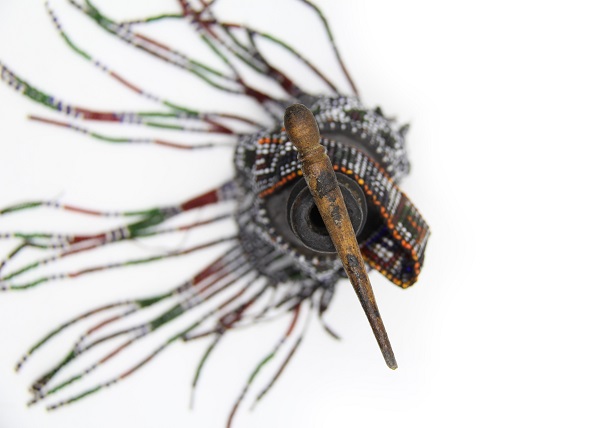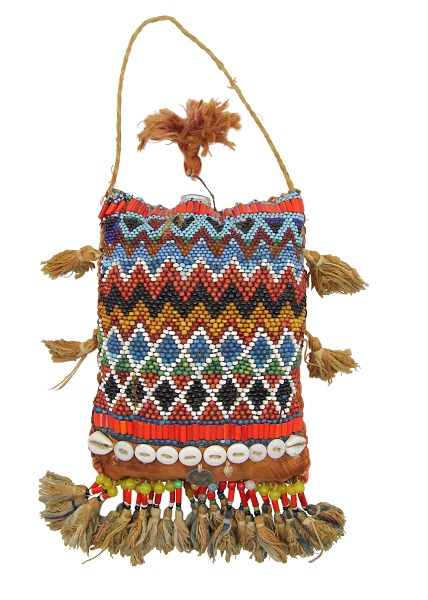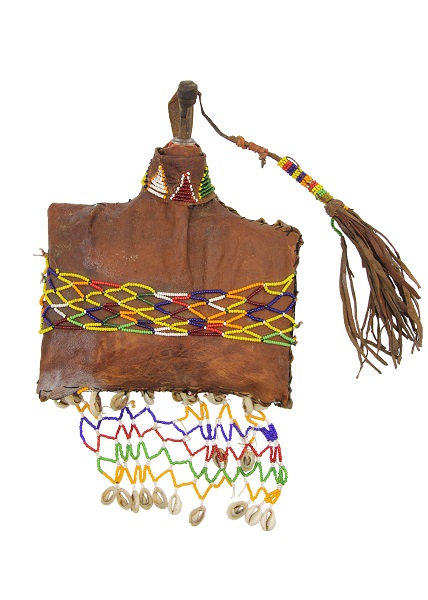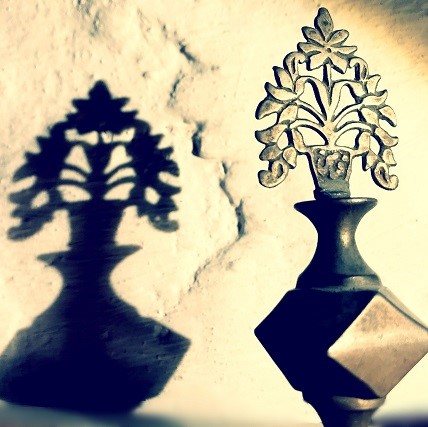In this post, Jolanda Bos, author of the book ‘Paint it, Black, a Biography of Kohl Containers’, takes us on a journey through the world of kohl – black eye paint – and its material culture. She shares the different values of the flasks and containers that hold this eye makeup. Even though this tradition is millennia-old and widespread, ‘Paint it, Black’ is - oddly enough - the first book on the subject. Jolanda Bos, as an archaeologist and dress anthropologist, didn't just focus on the different shapes of kohl containers throughout the ages, she also tried to answer the question of why the objects have attained these specific shapes and what these shapes symbolise in their different cultural settings.
 Kohl flask used in the Egyptian Eastern Desert, made from wood and decorated with glass beadwork (flask 14,5 cm long)
Kohl flask used in the Egyptian Eastern Desert, made from wood and decorated with glass beadwork (flask 14,5 cm long)A 1001 different materials and types
In many different cultures, kohl containers are the spontaneous products of home industries. They were often fashioned with materials that were readily available to their makers. A kohl flask might be (partly) made from a reused object (such as an empty medicine bottle or a potsherd) that would then be incorporated into the container. Therefore, a kohl holder often consists of several different materials such as leather, wood, reed, or textile, decorated with beautiful and meaningful patterns, techniques, and even other objects, such as glass or shell beads, buttons, and tassels. The decoration is applied in patterns that form potent symbols to which magical powers might be attributed. The quality of the end product, of course, entirely depends on the maker's skills. All in all, this spontaneous process by no means guarantees uniformity or continuity in shapes and types. And this can be seen over time in cultures in the Asian and North African regions. It does however guarantee an impressive multiformity, ánd the unique possibility to observe and trace the creator’s spontaneity and creativity. In addition, there are also cultures in which kohl containers are not made in a tradition of home production. Here these containers are produced by highly qualified craftsmen, such as jewellers, glass manufacturers, or woodcarvers.
 Palestinian cushion container in Atlas
Atlas: (Arabic and Aramaic: atlas – silk; from Greek: Atlas – Character from Greek mythology Synonym: adras, ikat, abr), a resist dyeing technique that involves tying and dyeing yarns or threads before weaving, resulting in a distinct pattern. With strong traditions sporadically across the globe it probably originated independently around the world.
Palestinian cushion container in Atlas
Atlas: (Arabic and Aramaic: atlas – silk; from Greek: Atlas – Character from Greek mythology Synonym: adras, ikat, abr), a resist dyeing technique that involves tying and dyeing yarns or threads before weaving, resulting in a distinct pattern. With strong traditions sporadically across the globe it probably originated independently around the world. Aṭlas: (Latin: Atticus Atlas
Atlas: (Arabic and Aramaic: atlas – silk; from Greek: Atlas – Character from Greek mythology Synonym: adras, ikat, abr), a resist dyeing technique that involves tying and dyeing yarns or threads before weaving, resulting in a distinct pattern. With strong traditions sporadically across the globe it probably originated independently around the world. – a large silk producing moth; from Greek: Atlas
Atlas: (Arabic and Aramaic: atlas – silk; from Greek: Atlas – Character from Greek mythology Synonym: adras, ikat, abr), a resist dyeing technique that involves tying and dyeing yarns or threads before weaving, resulting in a distinct pattern. With strong traditions sporadically across the globe it probably originated independently around the world. – character from Greek mythology; Synonym: harir), common term for silk in the Arab world especially the Levant.
silk with glass compartment, decorated with beadwork and tassels (22 cm long)Cultural domains of kohl
In the Palestinian region, kohl holders were traditionally fashioned by young women and future brides, and shaped like small textile pillows. The fabric they used was often decorated with embroidery displaying the same elements (including the attached beads and coins) that can also be found on traditional clothing from this region. This suggests that the kohl holders from Palestine are considered part of the cultural domain of ‘local or national costume’. Containers may even incorporate re-used dress panels. Here, kohl holders were created as part of the domain of women and their garments. In this region, the containers are also relatively large (sometimes up to 25 cm long) and were used during wedding ceremonies. In Oman,
dazzling silver kohl flasks belong to the domain of jewellery and social status. Apart from being a utensil, the flasks act as a status symbol for the owner and represent a certain economic value, similar to how jewellery represents value. They are placed inside the house, on tables, or may even be offered to guests to use. These findings provide us with the opportunity to understand and appreciate kohl containers in a very specific manner. With this knowledge, we may now, for instance, hypothesise about ancient kohl containers and their use. Considering the shape and materials used in ancient kohl flasks, we may be able to better understand usage, the cultural domains of kohl in the distant past or even fathom rituals involved.
 Leather cushion container from the South of Egypt with glass compartment, decorated with netted beadwork and cowries (19 cm long)
Leather cushion container from the South of Egypt with glass compartment, decorated with netted beadwork and cowries (19 cm long)Embedded personal memories
Traditional kohl flasks are very personal items, appreciated for various reasons. The flasks may have been worn as jewellery, gifted in dowries, or used as house amulets hung on walls or in tents, attracting good fortune. They may be decorated with beads that functioned as reminders or with small objects that hold personal memories, such as a coin acquired through distant trade or a much-treasured amulet. These memories may also be reflected by how a kohl container was produced: as part of a girl’s trousseau and made with reused, found, or otherwise meaningful objects, such as parts of a once treasured dress. Therefore, kohl containers may carry very personal memories. Kohl flasks from West Africa and the Maghreb are often made of leather, decorated with an assortment of beads and leather fringes. They were often incorporated into jewellery or displayed on the body. They may also be tucked away between different layers of clothing and hidden from view, literally close to the owner's skin for magical protection. This degree of intimacy is another important value that is embedded into these small objects.
 Omani silver kohl flask with characteristic silver applicator stick attached with a silver chain (4,3 cm long)
Omani silver kohl flask with characteristic silver applicator stick attached with a silver chain (4,3 cm long)To protect the eye
The word amulet has already been mentioned. In many cases, the containers are considered to have an apotropaic effect or the ability to attract good fortune. Their forms, the choice of materials, and the decorative patterns or elements play an important role in this belief. Coins jingle and shimmer in a spontaneous manner, keeping the Evil Eye at bay. In the South of Egypt in the Nile Valley, a leather pillow is modelled around a tiny glass bottle in which the kohl is stored. This pillow is decorated with a beaded net. Often, at the bottom of the beadwork, rows of cowrie shells are applied. This is a strong symbol of femininity and may attract fertility, success in childbirth, and also wealth. Again, in ancient cultures such as Pharaonic Egypt, similar references may be the starting point for future research to better understand the role of kohl flasks in this ancient society. The deities that are depicted on the Ancient Egyptian kohl artefacts refer to certain hazards for which protection was sought. But the kohl itself was and is also used as protection, against eye ailments, but also negative influences on a more mystical level.
 Copper kohl flask, acquired in Egypt, with an applicator that is elaborately decorated with floral motifs (9 cm long).
Copper kohl flask, acquired in Egypt, with an applicator that is elaborately decorated with floral motifs (9 cm long).The rich traditions of kohl
Since ancient times, applying kohl to the eyes has been an important tradition in the Asian and North African regions. This probably started as early as the Bronze Age and still exists today. Kohl was and is still used for its medicinal properties by men, women and children. Kohl is an Arabic loanword and can be roughly translated as ‘to beautify the eyes’, it does not describe the actual material of the makeup and the term is used here only to simplify matters. Black eye paint is referred to by many different names in many different cultures. The recipes for kohl that have been reported throughout history, vary hugely. From minerals that were ground into a powder, to collected soot deposits from lamp wicks. In the present as well as in the past, the material was pulverized and stored in the containers we have been discussing here. The kohl was, sometimes mixed with water, oil, or fat, applied on the eyes using simply a finger or a thin rod, often referred to as ‘the needle’. Today, these sticks are sometimes made of beautifully decorated silver, but can also be a mere thin reed. Thus, kohl containers and these applicator sticks are the physical and material outcome of the rich and varied tradition of the use of kohl.
 Jolanda's book - Paint it. Black, a Biography of Kohl Containers
Jolanda's book - Paint it. Black, a Biography of Kohl ContainersFurther Reading
Paint it, Black -
a Biography of Kohl Containers, Jolanda Bos, BLKVLD Publishers, 2019
‘This book covers the remarkable history of kohl containers from the Early Bronze Age to the present day, including ancient Egypt, ancient Persia, the culture of the Early Islamic Period and the present-day cultures of North Africa and West Asia. For thousands of years, people from all over the world have used body paint and kohl. A black powdery substance has been universally used by both men and women throughout history. The book also incorporates a catalogue of a unique collection of kohl containers kept in the Wearable Heritage collection.
Learn more about the book and Jolanda's passion for kohl containers in
this video.

About the Author
Jolanda E.M.F. Bos,
is an archaeologist and dress anthropologist. Her research fields comprise
archaeological beadwork analysis, contemporary costume, personal adornment (as the combination of dress, body decoration, veils, jewelry and amulets) and the social implications of dress.Over the last twenty years Jolanda has been working at several excavations in Egypt (at the moment at Tell el Amarna, Egypt) and the Netherlands, as well as on museum exhibits both in the Netherlands and in Egypt. At present she studies ancient Egyptian hairstyles from Tell el-Amarna at the University of Leiden (the Netherlands) as part of her PHD research.
Jolanda is the author of several articles and books (i.e., ‘Paint it, Black’ and ‘Egypt’s Wearable Heritage’), and regularly lectures on the subject. She is also the driving force behind the
Wearable Heritage website. Wearable Heritage is also on
Instagram account and
Facebook.
Copyright to all images belongs to Jolanda Bos. Used with permission.





 Kohl flask used in the Egyptian Eastern Desert, made from wood and decorated with glass beadwork (flask 14,5 cm long)
Kohl flask used in the Egyptian Eastern Desert, made from wood and decorated with glass beadwork (flask 14,5 cm long) Palestinian cushion container in Atlas
Atlas: (Arabic and Aramaic: atlas – silk; from Greek: Atlas – Character from Greek mythology Synonym: adras, ikat, abr), a resist dyeing technique that involves tying and dyeing yarns or threads before weaving, resulting in a distinct pattern. With strong traditions sporadically across the globe it probably originated independently around the world.
Palestinian cushion container in Atlas
Atlas: (Arabic and Aramaic: atlas – silk; from Greek: Atlas – Character from Greek mythology Synonym: adras, ikat, abr), a resist dyeing technique that involves tying and dyeing yarns or threads before weaving, resulting in a distinct pattern. With strong traditions sporadically across the globe it probably originated independently around the world.  Leather cushion container from the South of Egypt with glass compartment, decorated with netted beadwork and cowries (19 cm long)
Leather cushion container from the South of Egypt with glass compartment, decorated with netted beadwork and cowries (19 cm long) Omani silver kohl flask with characteristic silver applicator stick attached with a silver chain (4,3 cm long)
Omani silver kohl flask with characteristic silver applicator stick attached with a silver chain (4,3 cm long) Copper kohl flask, acquired in Egypt, with an applicator that is elaborately decorated with floral motifs (9 cm long).
Copper kohl flask, acquired in Egypt, with an applicator that is elaborately decorated with floral motifs (9 cm long). Jolanda's book - Paint it. Black, a Biography of Kohl Containers
Jolanda's book - Paint it. Black, a Biography of Kohl Containers